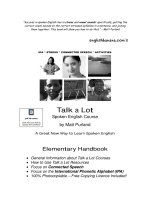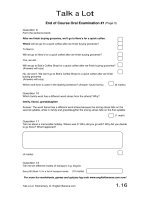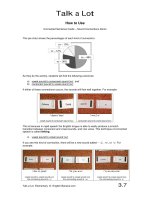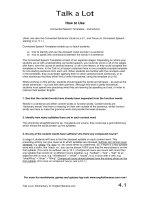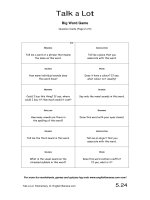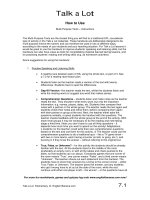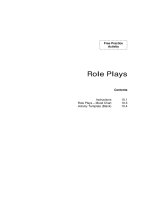Tài liệu Spoken english elementary handbook part 4 pptx
Bạn đang xem bản rút gọn của tài liệu. Xem và tải ngay bản đầy đủ của tài liệu tại đây (212.38 KB, 15 trang )
Talk a Lot
How to Use
Sentence Blocks – Instructions
For more fun worksheets, games and quizzes log onto www.englishbanana.com now!
Talk a Lot Elementary © English Banana.com
2.2
The teacher:
OK. [Writes “Where” underneath the starting sentence.] To make the second line can you ask
a “where” question based on the starting sentence?
The student:
Where did you see a great jazz concert last night?
The teacher:
Good. Very good. Excellent.
Note: if a student has a problem producing any part of the sentence block, the teacher should
prompt them with the first word, then the next, and in this way “coax” the sentence out of them
by, if necessary, saying the whole sentence and getting the student to say it with them, then
to repeat it without the teacher’s help.
The teacher:
And what is the short answer?
The student:
At the Palace Theatre.
The teacher:
OK. Great.
Note: it is very important that the teacher praises the student as they get sentences right and
gently encourages them when they have taken a wrong turn. It is also important for the
teacher to keep the momentum going so that the sentence block is made with a sense of
rhythm and an almost urgent pace. This will keep the student focused and thinking about the
task in hand.
The teacher:
So now we’ve got three lines. Can you repeat them for me? [The student does so correctly.]
Now, let’s get to five lines. Ask a question with inversion.
The student:
Did you see a great jazz concert at the Palace Theatre last night?
The teacher:
Good. And the short answer?
The student:
Yes.
The teacher:
Yes, what?
The student:
Yes, we did.
Talk a Lot
How to Use
Sentence Blocks – Instructions
For more fun worksheets, games and quizzes log onto www.englishbanana.com now!
Talk a Lot Elementary © English Banana.com
2.3
The teacher:
Good. Very good. So now we’ve got five lines. We’re almost there. Can you repeat the five
lines, please? [The student does so correctly.] OK, so, to complete the sentence block, let’s
ask the same kind of question with inversion but this time to get a negative answer. Look at
the question word. Focus on the “where”. Change the “where” to get a negative answer.
The student:
Did you see a great jazz concert at the Roxy last night?
The teacher:
And give a short answer in the negative.
The student:
No, we didn’t.
The teacher:
Then a full negative answer. The last line is made up of two negative sentences.
The student:
We didn’t see a great jazz concert at the Roxy last night.
Note: students have to invent something here (“…at the Roxy last night?”) that makes sense
in the same context. They should try to think of a sensible option to get a negative answer.
For example, the teacher must not accept: “Did you see a great jazz concert at the
newsagent’s last night?” because it doesn’t make sense. Students often struggle to remember
to make two negative sentences for the last line. Encourage them and stress the two negative
sentences.
The teacher:
Excellent! Now tell me all seven lines…
Throughout, the teacher should help the student to achieve the correct pronunciation,
sentence and word stress (see sections 12 and 13 of this handbook), rhythm and intonation. If
a student makes a mistake during a line, ask them to repeat the whole line again. Of course,
in the example above the student has given almost all of the correct answers straight away.
This is purely to serve a purpose in this handbook – to give a clear example of what the
students should aim for. The teacher should also encourage the students to think about word
and sentence stress and to emphasise the correct words in each sentence, for example:
Did you see a great jazz concert at the Palace Theatre last night?
Yes, we did.
Did you see a great jazz concert at the Roxy last night?
No, we didn’t. We didn’t see a great jazz concert at the Roxy last night.
Students may have a tendency to try to say all seven lines with a questioning intonation at the
end of each line. For example, they might say:
Talk a Lot
How to Use
Sentence Blocks – Instructions
For more fun worksheets, games and quizzes log onto www.englishbanana.com now!
Talk a Lot Elementary © English Banana.com
2.4
The student:
Did you see a great jazz concert at the Roxy last night? No, we didn’t?
Ask them to think about the meaning of what they are saying and to make definite statements
without the questioning intonation. Some students may try to gabble and deliver their lines
very quickly without apparent thought of what they mean – wholly focused on their goal of
remembering each line and forming the sentence blocks as quickly as possible. Ask them to
slow down and to focus on what each sentence means.
So, in the example above the seven lines and eight sentences of the sentence block are:
1. We saw a great jazz concert at the Palace Theatre last night. (starting sentence)
2. Where did you see a great jazz concert last night? (wh- question)
3. At the Palace Theatre. (short answer)
4. Did you see a great jazz concert at the Palace Theatre last night? (question with
inversion)
5. Yes, we did. (short answer)
6. Did you see a great jazz concert at the Roxy last night? (question with inversion to get a
negative answer)
7. No, we didn’t. We didn’t see a great jazz concert at the Roxy last night. (two sentences –
a short negative answer and a long negative answer)
The teacher should ensure that the students follow the sentence block structure and that they
recap each group of sentences after the 3
rd
and 5
th
lines. If a student has a tendency to
“Um…” and “Er…” their way through each line, challenge them to say the lines without doing
this. As they monitor the pairs engaged in making the sentence blocks – saying one line each
– the teacher will sometimes need to be firm with the students, and ask them to keep focused
when it looks as though their minds are beginning to wander, and of course the teacher also
needs to keep focused! For example, when leading sentence block practice at the front of the
class, the teacher will need to be one step ahead of the students and know the next sentence
in their mind – what they want the student to produce – before the student produces it.
Embedded Grammar
In each lesson students will practise making positive sentences, negative sentences, and two
different kinds of question forms using the following verb forms:
• present simple
• present continuous
• past simple
• past continuous
• present perfect
• modal verbs (e.g. can, should, must, have to, etc.)
• future forms (with “will” and “going to”)
• first conditional
Talk a Lot
How to Use
Sentence Blocks – Instructions
For more fun worksheets, games and quizzes log onto www.englishbanana.com now!
Talk a Lot Elementary © English Banana.com
2.5
While doing sentence block practice the students may be unaware that they are using eight
different verb forms. It is better not to focus on this and blow their minds with grammar, but
instead make sure that the students are making the sentence blocks correctly. For example, it
is essential that students understand the eight starting sentences on the board or handout at
the beginning of the lesson, and also know how to make a sentence block, before they begin
pair work with a partner.
The starting sentences all contain embedded grammar, which means grammar that occurs as
a natural part of the sentence block as it is being spoken and automatically memorised, rather
than grammar that is explicitly presented to students as an isolated grammar topic, such as:
“In today’s lesson we are going to study wh- questions…” etc. The embedded grammar in the
sentence blocks at Elementary level includes:
• positive and negative forms
• use of articles
• use of auxiliary verbs
• a variety of main verbs in each unit
• subject and object pronouns
• yes/no questions
• wh- questions
• active and passive sentences
• punctuation marks
• prepositions of place and time
• some/any
• singular/plural
• nouns: common, proper, abstract, countable, uncountable, etc.
• intensifiers – too, really, very, completely, etc.
• use of infinitives
• adjectives
• adverbs of frequency and manner
• possessive pronouns
• determiners – this, that, those, these, etc.
• there is/there are
• formal and informal situations
• use of gerunds
• comparatives and superlatives
• relative clauses – that, which, who, where, etc.
The teacher could pick up on any or all of these grammar topics in more detail if they run the
course as a 60-hour course (see Course Outline on p.1.2).
Miscellaneous Notes
• As well as with students in groups and pairs, this method can also be used
successfully with students on a one to one basis, with the teacher prompting the
student to produce the sentence blocks, first with the sentences on the board or
handout, and later from memory.
Talk a Lot
How to Use
Sentence Blocks – Instructions
For more fun worksheets, games and quizzes log onto www.englishbanana.com now!
Talk a Lot Elementary © English Banana.com
2.6
• Teachers (or students) can also imagine their own starting sentences based on the
verb form or vocabulary that they wish to practise (see blank template on p.2.7).
Different Ways to Practice Forming Sentence Blocks
• In a circle – the teacher or a student leads and chooses each student in turn to form
the complete sentence block.
• The students sit back to back in pairs and say one line each, then reverse who starts.
• The students chant a complete sentence block altogether as a group.
• The students say one line or one word each, going around the group in a circle.
• The teacher says a random line from a sentence block and asks a student to produce
the next line.
Note: every sentence block can be said or chanted in a continuous way by adding an eighth
line at the end that begins with “So…” and continues with the question on line 2. For
example:
Line 1: Joanne can play the saxophone really well.
Line 2: Who can play… [etc.]
Line 7: No, he can’t. George can’t play the saxophone really well.
Line 8: So, who can play… [then, continuing with line 3, “Joanne can.” and so on…]
Talk a Lot
Topic: __________________
For more fun worksheets, games and quizzes log onto www.englishbanana.com now!
Talk a Lot Elementary © English Banana.com
2.7
Sentence Blocks
1.
Verb Form: _________________
Starting Sentence: ________________________________________________
________________________________________________
Question Word: _________________
2.
Verb Form: _________________
Starting Sentence: ________________________________________________
________________________________________________
Question Word: _________________
3.
Verb Form: _________________
Starting Sentence: ________________________________________________
________________________________________________
Question Word: _________________
4.
Verb Form: _________________
Starting Sentence: ________________________________________________
________________________________________________
Question Word: _________________
5.
Verb Form: _________________
Starting Sentence: ________________________________________________
________________________________________________
Question Word: _________________
6.
Verb Form: _________________
Starting Sentence: ________________________________________________
________________________________________________
Question Word: _________________
